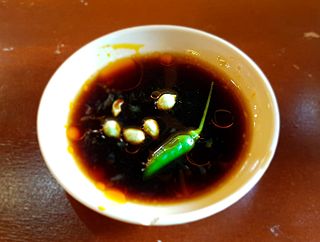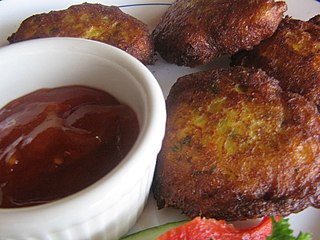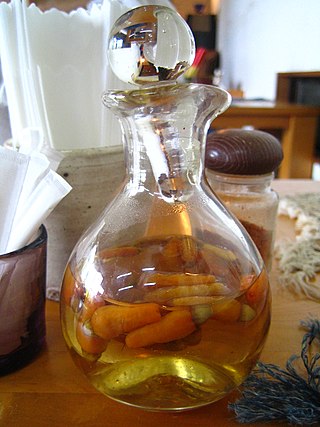Related Research Articles

Ajvar is a condiment made principally from sweet bell peppers and eggplants. The relish became a popular side dish throughout Yugoslavia after World War II and remains popular in Southeast Europe.

Gochujang or red chili paste is a savory, sweet, and spicy fermented condiment popular in Korean cooking. It is made from gochu-garu, glutinous rice, meju powder, yeotgireum, and salt. The sweetness comes from the starch of cooked glutinous rice, cultured with saccharifying enzymes during the fermentation process. Traditionally, it would be naturally fermented over years in jangdok (earthenware) on an elevated stone platform called jangdokdae in the backyard.

Hot sauce is a type of condiment, seasoning, or salsa made from chili peppers and other ingredients. Many commercial varieties of mass-produced hot sauce exist.

Garlic chutney, also referred to as lahsun chutney, lahsun ki chutney, lehsun chutney and bellulli chutney, is a chutney, originating from the Indian subcontinent, made from fresh garlic, dry or fresh coconut, groundnuts and green or red chili peppers. Cumin and tamarind are also sometimes used as ingredients. It is prepared in both wet and dried forms. The wet variety is made with fresh grated coconut and is typically served immediately after preparation.

The generic term for condiments in the Filipino cuisine is sawsawan. Unlike sauces in other Southeast Asian regions, most sawsawan are not prepared beforehand, but are assembled on the table according to the preferences of the diner.

Chili sauce and chili paste are condiments prepared with chili peppers.

Different areas of the world have local variations on the hot dog, in the type of meat used, the condiments added, and its means of preparation.

Barbecue sauce is a sauce used as a marinade, basting, condiment, or topping for meat cooked in the barbecue cooking style, including pork, beef, and chicken. It is a ubiquitous condiment in the Southern United States and is used on many other foods as well.

Salça ("salcha") is a category of thick, deep red paste made from peppers or tomato and salt, originating in Turkey.

Balinese cuisine is a cuisine tradition of Balinese people from the volcanic island of Bali. Using a variety of spices, blended with the fresh vegetables, meat and fish. Part of Indonesian cuisine, it demonstrates indigenous traditions, as well as influences from other Indonesian regional cuisine, Chinese and Indian. The island's inhabitants are predominantly Hindu and culinary traditions are somewhat distinct with the rest of Indonesia, with festivals and religious celebrations including many special foods prepared as the offerings for the deities, as well as other dishes consumed communally during the celebrations.

Pique is a traditional hot sauce from Puerto Rico that is typically made with a variety of chili peppers, garlic, and spices. It is often made by fermenting the ingredients, which can give it a unique flavor profile and a more complex taste. Some variations may include ingredients such as cilantro, oregano, or onions. Pique is commonly used as a condiment for a variety of traditional Puerto Rican dishes such as rice, beans, and meat dishes. It can also be used as a marinade for meats or as a dip for tostones or other fried foods. Pique is a staple condiment in Puerto Rico and is often homemade, but can also be found in grocery stores.

Chili oil is a condiment made from vegetable oil that has been infused with chili peppers. Different types of oil and hot peppers are used, and other components may also be included. It is commonly used in Chinese cuisine, Southeast Asian cuisine, Italy, and elsewhere. It is particularly popular in Chinese cuisine, especially western Chinese cuisines such as Sichuan cuisine, Hunan cuisine, Guizhou cuisine, and Shaanxi cuisine where it is used as an ingredient in cooked dishes as well as a condiment. It is sometimes used as a dip for meat and dim sum. It is also employed in the Korean Chinese noodle soup dish jjamppong. A closely related condiment in Chinese cuisine is chili crisp, which contains edible chunks of food and chilis in oil.

Kōrēgusu, also called kōrēgūsu (コーレーグース) and kōrēgusū (コーレーグスー), is a type of Okinawan chili sauce made of chilis infused in awamori rice spirit and is a popular condiment to Okinawan dishes such as Okinawa soba.

The capuliato or capuliatu is a traditional condiment of Sicilian cuisine based on dried tomatoes, linked, in particular to the territory of the Vittoria Plain, in free municipal consortium of Ragusa. The original name is capuliato, meaning 'minced'.

Chili crisp, chile crisp or chili crunch is a type of hot sauce, originating from Chinese cuisine, made with fried chili pepper and other aromatics infused in oil, sometimes with other ingredients. Multiple regional, homemade, and restaurant-original versions exist across China. The best-known commercial brand is Lao Gan Ma, which is based on the chili crisps of Guizhou province. The chili crisp is closely related to Chinese chili oil, and sometimes the two terms are used interchangeably, the difference being that the crisp contains edible chunks of food in the chili oil.
References
- ↑ Chili pepper water: popular Hawaiian condiment. Accessed 2016-10-26.
- ↑ "Chili pepper water a homemade specialty - The Honolulu Advertiser - Hawaii's Newspaper" . Retrieved 13 September 2016.
